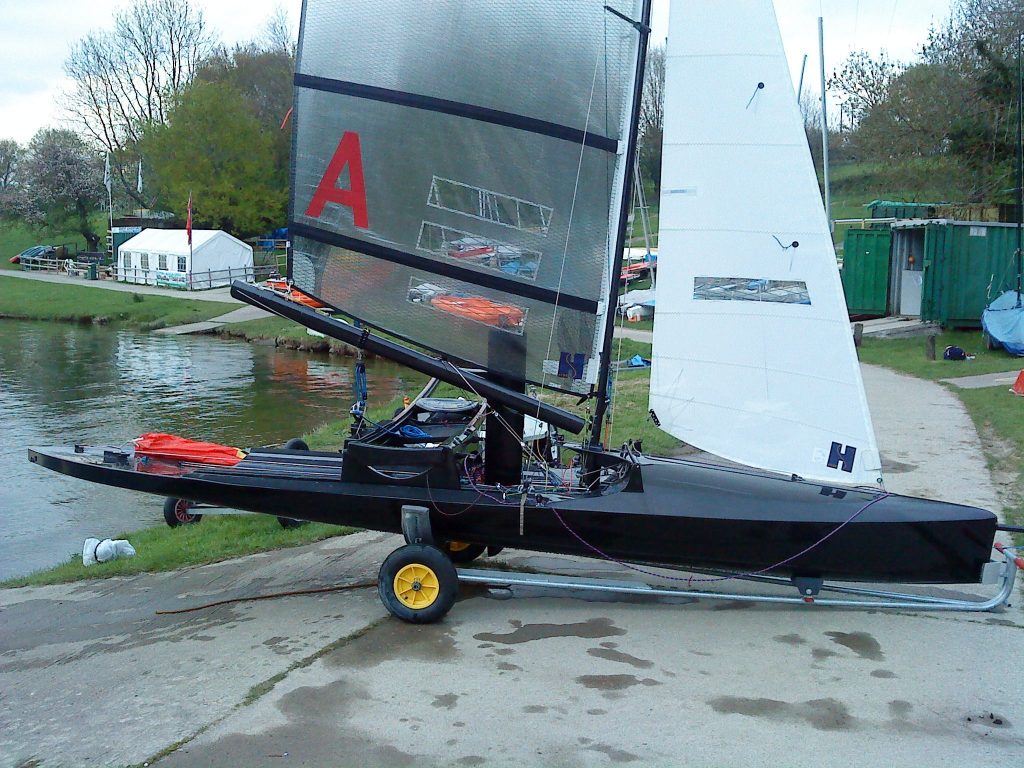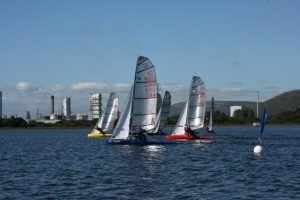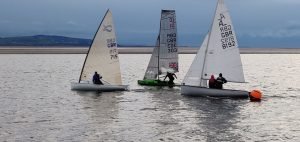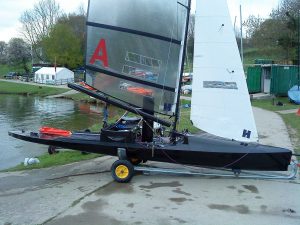Jet is a new Asymmetric Canoe (AC) built by Steve Clarke who was inspired to build a new boat when visiting the workshops of class boat builder Rob Michael of Razorback Boats, the main developer behind the asymmetric version of the fast, super sleek IC.
Ideas for a new deck layout evolved over a period of 2 years through sailing a latest Razorback design along with a few new ideas to develop the AC concept further particularly for the bigger guys. The AC has become a great leveler in that sailors in a weight range of 70-100kg can compete on more or less equal terms.
Being an ultra slim boat means being nimble is essential especially when the wind gets up. In addition the act of hauling a 23m2 spinnaker up and down whilst balancing on a boat only 1m wide is quite a challenge. The main criteria for improvement concentrated on the following ;
· Under deck spinnaker chute to keep the narrow deck clear of the sock and ropes
· Reduction of friction on spinnaker halyard and pole mechanism
· Radical departure on the sliding seat design to improve mobility along the seat
· More aerodynamic deck shape and a fresh look at styling
· All carbon look deck for a modern high tech boat
The development of these ideas went along in parallel with development of new foils from Mike Cooke and spars with Terry Cooke at Aardvark Technologies and Spars respectively. Terry has developed a new set of spars based on Moth high modulus designs and Mike with his vast experience of latest foiling technology produced a molded, high aspect, low drag dagger board. The rudder is a new design from new rules IC sailor Alistair Warren.The hull shape for an AC is one design based on the Nethercott lines and the shell was made from a standard Razorback mold, The deck is completely open to interpretation within the class rules. Getting the chute under the deck required that the rear deck be raised slightly to ensure water can drain away by following the line of the standard deck line. The fore section of the chute needs to be lower in the boat to get a straight line run, necessary to avoid turning corners which will generate friction. Additional height on the deck raises C of G but the benefit of not tripping over a slippery sock on a narrow deck should hopefully compensate for this.
The chute mouth is bigger to allow the kite to go deeper into the hull and also to reduce friction as the large kite bunches when being pulled down. A roller has been incorporated inside the mouth to again reduce friction as the downhaul turns 90o to return down the chute. Jet has been designed to operate with or without the pump system traditionally used on the AC to experiment with using handover hand uphaul in lighter conditions.
Another design feature is a centralized spinnaker pole with the mechanism using an open “canyon” running down the middle of the foredeck as a stressed member. This also keeps all the various ropes and pulleys off the foredeck also housing forestay and jib controls. Jet has a removable carbon cover to maintain this clean shape and reduce water intake but still allow ease of access.The central mast post took many weeks of planning as the canoe does tend to have quite a few control lines and housing them all in a convenient and workable fashion is something of a logistical and ergonomic challenge. Many of the lines need to be accessible when out on the 2m seat so correct placement of controls is essential. This aspect will doubtless develop with the boat as she is developed further.
The deck is foam/carbon with clear coat epoxy which for an amateur without molds is a hugely time consuming activity requiring much patience and elbow grease.The shape of the deck is inspired by the latest trend for rounded features and takes cues from the latest designs in boats such as the Nat12 and is intended to reduce the aerodynamic drag and quickly shed water collecting on the foredeck. To compensate for the larger chute mouth a quick draining tube is fitted with funnel shape at the base of the chute entrance and is kept as low and aft as possible. The foredeck is also much higher in the front third to give more freeboard.

The final feature developed on Jet, is a new take on the famous sliding seat. The design features carbon outriggers which slide through the carriage. The carriage holds the seat and has fore/after runners on tracks to move weight backwards. On Jet the runners are recessed into the deck and are set inboard to give more foot room on the gunwale for launching out on the seat and general stability during tacks. Keeping the runners off the deck away allows lubricant to be used more readily to make fore and aft movement of the carriage easier to perform but not so easy that the whole mechanism flies forward when diving into the back of a wave!
The seat outriggers have been specially built to be very strong but lightweight using a carbon and Kevlar mix. The outriggers have an inner rail on which runs an actual seat which is free running. The intention is that the outriggers once tacked will remain fully extended and the sliding inner seat will move easily with the helmsman. This is intended to allow weight to be moved in and out quickly allowing the heavier helm to compensate quickly to lulls and gust. It also has the advantage of avoiding the famous canoe sailors bottom abrasion problem, caused by shuffling up and down the standard seat—a topic of hot debate discussed on the classes popular forum found via the website.
All in all, the new concepts introduced on Jet hopefully will help to make people challenge traditional ideas and keep the boats fresh. The intended outcome is to move forward with the class and introduce new ideas and stimulate debate on how to make the unique design of the class prosper.
The introduction of new component makers such as Aardvark is helping to breathe new life into older boats many of which are carbon and have a lifetime of many decades to come.
Steve Clarke




